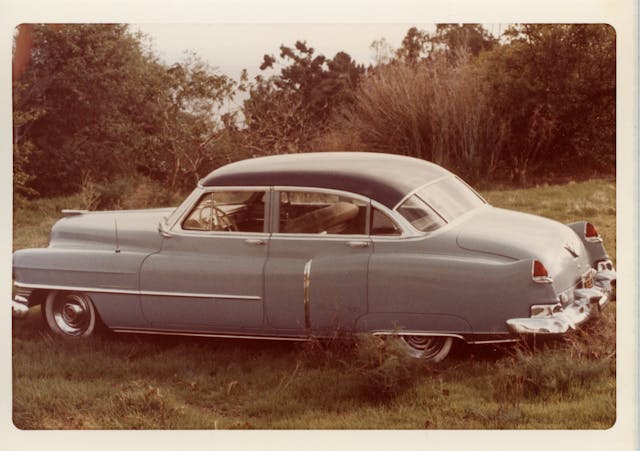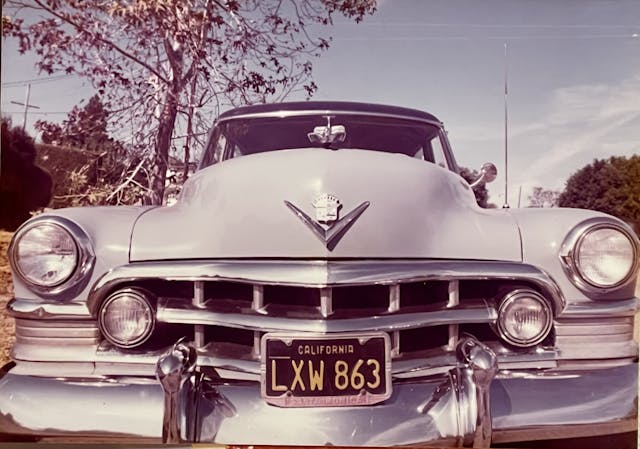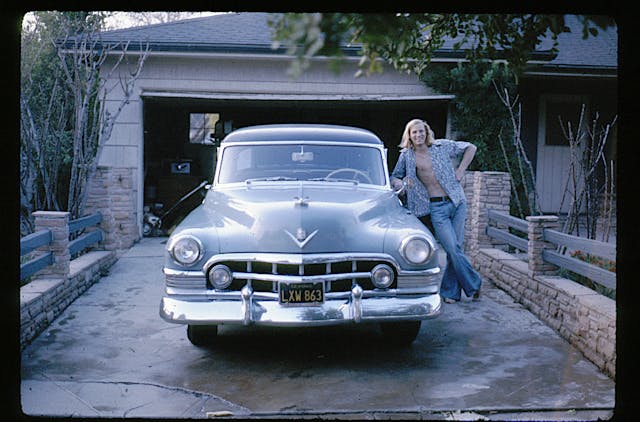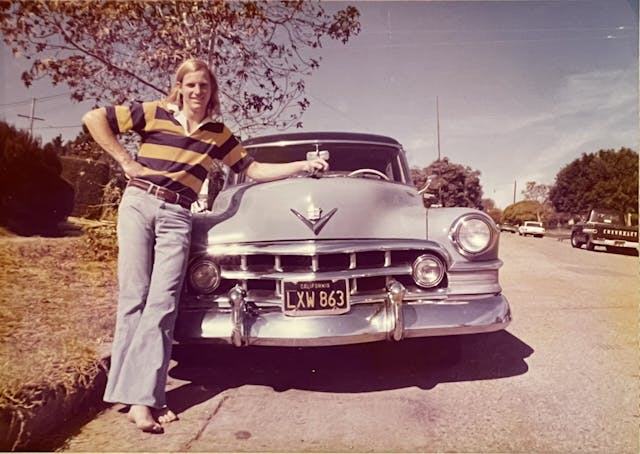How a Cream-Puff Caddy Introduced Me to Elegance
Today, the average price of a home in Brentwood, California, is $2.7 million. Back in 1975, though, a typewriter salesman could afford one. I recall that distinctly, because this one-owner, garage-kept 1950 Cadillac Series 62 sedan was purchased from just such a gentleman, for $350, and he named the price.
After learning about the Caddy, I begged a ride to his Brentwood residence to complete the deal, then drove home and dug into my favorite work—car detailing. The chrome and stainless—lots of it, thanks to GM design honcho Harley Earl’s penchant for brightwork—polished up beautifully, and the 25-year-old lacquer responded nicely to rubbing compound, waxing, and buffing (Turtle Wax all the way!).

The car’s only blemish, besides a cloudy headlight and one door that had been resprayed a slightly incorrect Corinth Blue, was—and I’m not joking—a grease-stained rear seat. Because that’s where the demonstrator typewriters always rode, and over time they left their mark.
Materials in the Fleetwood-designed, two-tone interior were magnificent: wool carpets and upholstery, napped cotton headliner, tasteful chrome dashboard features, an ivory-like steering wheel and levers. After its vacuum tubes warmed up, the Delco radio demonstrated fine reception of classical music, news reports on the U.S. withdrawal from Vietnam, and even disco (barf!).

Modeling Cadillac’s immediate postwar design language, everything about the car registered as calm, elegant, and “old money.” Even the electrics seemed old-world; using six volts, the illumination was categorically serene, from the headlights to the soft interior and instrument lights. Even the starter for the 331-cubic-inch, 160-hp V-8 was unhurried at best. Befitting its pampered life, the Caddy nonetheless started, ran, and drove wonderfully. Smooth-riding on a yawning 126-inch wheelbase, it truly was the “Standard of the World,” as the Cadillac Motor Car Division advertised.
Besides a noisy muffler, only one service issue arose. When the hidden brake master cylinder went dry, the pedal sailed right to the floor while I was approaching a four-way stop. In a panic, I blasted the horn, swung hard right, and, lacking seatbelts, hoped for the best. (I didn’t think of yanking the emergency brake.) Luckily, no harm came of the crisis.

Although the Cadillac didn’t stick around long, a lesson imparted by that near-miss did: On older vehicles that predate various sensors and warning lights, keep tabs on everything. Because, left to their own devices, these cars will neither warn nor save you. En garde!
***
Check out the Hagerty Media homepage so you don’t miss a single story, or better yet, bookmark it. To get our best stories delivered right to your inbox, subscribe to our newsletters.



Older cars really are not much different. They just ask for you to care for them and pay attention like a good driver should be.
They also asked you acquire the basics in car control like hard braking and skid control. They said turn into the skid and pump the brakes today it is stab the brakes and let the computer do it.
Though times were simpler they were not really all that bad.
And no these cars did not blow up if they went off a cliff. LOL!
You must be mistaken. I’ve seen lots of ‘70s crime shows, and they always blow up.
It is cars like this that are missing from todays hobby. This is where the kids got involved. Sorry a 8 year old rusted Honda is just not the same.
Mine was a 1956 Series 62 convertible, it was a great ride!
My first car in the mid ‘80s was a ‘51 Hudson Hornet with a Clifford built 308 6 cyl, Holley 850 and a D&F built Hydramatic. I received years after my father passed away when I was 4. Otherwise all stock. I still have the car although wrecked and in pieces. I have 14 Hudsons now all stemming from that first one.
I still have my ‘51 Hudson pacemaker that my grandfather bought new. After three single pot brake failures and some creative exiting from the traffic lanes the whole system was replaced with modern hydraulics and friction material. A great riding and handling car made better once it was introduced to radial tires.
The world – at least in the US – was so different back then, and there are SO many reasons for preferring it to current times. By the same token, ignorance is bliss, as the old saying goes…but I’d argue that “ignorance” in this case may be a bit harsh, and arguably a better word would be innocence. Being a late-1951 model myself, I remember ’50s cars as essentially friendly and easygoing, though punishment awaited right at their limits…operational talent was required.
I had a 1947 Plymouth when I was 19. Learned some basic wrenching skills with it. Nothing I couldn’t fix included: head gasket, rear brakes, burned out headlight and radiator clean out. Loved that old car but my 69 mustang was my daily driver. Eventually sold the old Plymouth in 1972 when I moved into an apartment complex that only had one parking space per apartment. Years later, as in 2022, I purchased a rust free 1940 Plymouth 2 door sedan out of Albuquerque, NM. Still driving it today, a great reminder of my youth.
@hyperv6
A 25 year old car is 1999.
Somehow that doesn’t seem that old to me 🙁
Yeah – frightening, isn’t it, how recent that really seems?
In 1970 at 19 years old, I bought a 1954 Pontiac Chieftain 4 dr. sedan for $100, from the original owner. It had the straight 8 with a 2 bbl. Carter, automatic trans, roof windshield visor, skirts, and power windows, in the front doors only. Since it was a 1 owner car it was mint. It had the loudest AM radio I ever heard. I learned years later reading in Hemmings that this model offered a 7 tube radio instead of the 6 tube, as an option.
I drove that car from Massachusetts to California that same year. Not too many kicks on route 66 on that trip, but I wish I still had that car now.
That Cadillac “62” is a beautiful car. Elegant indeed!
They may save you because of their size. If going slow enough.
Nice car
Love all the stories and tales about the cars from John L. Stein. More please.
I got close. 1949 Oldsmobile with the Rocket V8.
I never owned a Cadillac, but during my college years (1956-60) I owned a coupe of Chevrolets (49 & 51), but my favorite was a 1952 Pontiac convertible with the flathead straight 8 engine and the first dual range (D1 & D2) automatic transmission. – It was a great campus car as we could fit up to 7 or 8 in those great bench seats and cruise around with the top down during Fall & Spring quarters at Kent State in Ohio.
Although I was not great at routine maintenance all three of those GM cars gave me great reliable service.
Great comments by all pertaining to the 1950 Caddy article.
My teen years were in the mid-70’s; these cars were all junk in FLA. All rust; no redemption. Still remember Ma and Pa Kettle, and all the Kettlets filing out of a clapped out four door 50-ish Chevy/Ford/Whatever at our local 7-11 (pre-gas pump era). Seemed to be tall cotton for them at the time. My buds and I were there for the 25 cent 16 oz. Pepsi (twisted glass bottle TYVM) and 10 cent 3-Musketeers Bars. Bye bye healthy teeth; hello 2X cavities.